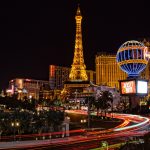How Commercial Air Travel Has Changed
When you think of the early days of flying, do you picture the 1940s era of flight attendants serving cocktails to passengers in spacious seats? While this is a somewhat accurate depiction, there’s more to the reality of it.
How Commercial Air Travel Has Changed
The truth about early air travel is that it was anything but glamorous. As exciting as it was to travel by plane, it left a lot to be desired.
What Early Commercial Flights Were Like
The first commercial airplanes didn’t have pressurized cabins, so they flew much lower than they do today. As a result, flights were full of turbulence and passengers commonly got airsick. Additionally, the airplanes weren’t heated or well insulated, so the cabins were cold and it was louder than it is today.
Flying in the 1920s
If you think it’s a hassle to get through airport security, navigate to a terminal, and then hustle for a seat, imagine what it was like in the 20s. Passengers on commercial flights would queue on the tarmac waiting to board. While this is still a practice today when flying out of a small jetport, it’s much more common to walk down a protective jetway to get you from the airport terminal to your seat.
As unpleasant as a flight may be physically, flight attendants did their best to make other aspects of the journey feel luxurious. It was expensive to fly, and passengers enjoyed food and drink which correlated to the high price of airfare. While passengers in the 20s didn’t enjoy individual TV screens on their flights, sometimes a projector was used to show a movie on a communal screen near the front of the passenger cabin. Thankfully, most movies in the 1920s were silent films, because there’s no way passengers could have heard any dialogue over the noise of the engines.
In these early years of flying, passengers dressed to impress, a trend that would persist well into the 1980s.
Airline Food in the 20s
With less efficient engines in the 1920s than today, weight restrictions were strict. If you think it’s a challenge to get your suitcase to make weight for your flight, back in the 20s the passengers were also weighed!
In an effort to reserve energy for the engines, meals were often served cold in the 1920s. Passengers could enjoy a selection of cold chicken, salads, sandwiches, and ice cream.
Flight Attendants in the 20s
Known as Cabin Boys, flight attendant jobs were primarily held by men in the 20s. It wouldn’t be until the 1930s that a woman would work for an airline as a nurse/steward on board a flight.
Flying in the 1930s
Although flying remained a bit primitive well into the 30s, the Smithsonian National Air and Space Museum records show that the number of passengers on commercial flights increased significantly.
- 1930 – 6,000 passengers annually
- 1934 – 450,000 passengers annually
Flights graduated to crossing the Atlantic Ocean when previously flights were just over land. It provided newfound access to Europe, whereas before people had to travel by boat.
Airline Food in the 30s
In-flight meals evolved, with passengers enjoying warm meals on their journies. Adding kitchens to airplanes meant the dining experience could resemble that found in a restaurant. PanAm is known for having a dining room onboard, ushering passengers to dine in small groups. Meals included a variety of drinks, seafood, fresh fruit, and salads. It truly felt like a fine-dining experience, complete with an always-flowing bar.
As more people began to fly in the 30s, airlines used meal times as a chance for passengers to find comfort by gathering together with each other and the crew. Also, having people gather at communal tables, with food served buffet-style, prevented flight attendants from having to hand-deliver trays and run the risk of dropping everything due to turbulence.
Flight Attendants in the 30s
As mentioned, women started fulfilling the role of air stewards in the latter half of the decade. They had strict guidelines, such as being a certain height, being unmarried, and maintaining a certain weight.
Flying in the 1940s
Although it was still possible to fly commercially in the 40s, World War II slowed passenger flying significantly. More emphasis was put on warplanes, but the additional runways built for WWII would continue to prove useful after the war. You can read more bout the evolution of aircraft in the 40s on the FLT blog HERE.
One big improvement to flying in the 40s includes the introduction of pressurized cabins. This meant planes could fly at higher altitudes (20,000 feet), reducing turbulence. The 40s are often referred to as the “Golden Age of Travel” because flights were more comfortable than they’d ever been before.
Airline Food in the 40s
Remember frozen TV dinners? They were popular in the mid-1900s, and airlines started serving them on flights. It increased the variety of meals they could serve, which was especially helpful since more people were flying. Having frozen meals at the ready meant passengers could have options, and wouldn’t be served the same meal on consecutive flights.
Flying in the 1950s
Jetliners were a big deal in the 50s, boasting more room for passengers than ever. They not only provided more space, but they featured more efficient engines that allowed for a wider variety of flight options.
Airline Food in the 50s
With airplanes’ carrying capacity improving, it meant meals could continue to grow in elegance. Long gone were the days of serving cold, light meals on thin china or in picnic-style wicker bowls. Airlines could now dish up meals on the finest of heavyweight china with real flatware.
Flying in the 1960s
Still in the “Golden Age,” flights started to include more opulent dinner-time meals to help pass the time and make the cost of airfare worth it. Multiple courses would be served, and it served as the so-called entertainment on the flights; it was enough because jetliners shortened travel time nd movies still weren’t commonplace on planes.
How Food Service Changed in the 60s
Because the turnaround time decreased, airline meals were often served on disposable plates to eliminate the need to wash dishes in-flight. If the emphasis had to be on fast, but in-fashion food, airlines went for something that could be eaten without silverware.
Flying in the 1970s
Here’s where to start to see real differences between first-class and economy cabins on airplanes. Not just in the price difference, but the services included. Room to spread out in the cabin was reserved for first-class passengers, who sometimes had access to onboard lounges when they wanted a change of scenery.
Airline food in the 70s
Passengers traveling economy, or on budget airlines, had to purchase meals at an additional cost when flying. Alcoholic beverages were still available at no charge to first-class passengers, but everyone else had to pay extra. Long gone were the days of flying in a plane with an open bar!
Flying in the 1980s
Airlines introduced smoking and non-smoking sections, but you can probably imagine how successful it was to separate passengers from cigarette smoke. It was more of a technicality than a reality to have a non-smoke-filled section of the plane. Thankfully, by 1988 smoking bans would be implemented on certain flights.
By now, dress codes were relaxing slightly, but passengers could be denied first-class seats if they weren’t dressed properly according to the airline. Airlines started offering bundled vacation packages, including airfare and accommodations for convenience.
Flying in the 1990s and Beyond
Budget airlines cropped up in the 1990s, putting more luxury airlines out of business. Air travel became more accessible to the masses, but there were fewer perks included.
Airline Fees Today
When you fly today, not only do you have to have liquids separated into 3.2oz containers, remove your shoes for security, and limit your checked bag weight to 50 pounds, but you have to pay more for certain things, such as:
- Assigned Seats
- Meals/Snacks
- Headphones
- Checked Luggage
However, there are more conveniences than ever before. You can book a flight on your phone in a matter of minutes, and check-in online before you arrive at the airport. In-flight entertainment often includes a personal screen on the headrest in front of you, and you can access Wi-Fi while flying for work or leisure purposes.
While flying is less of a luxury and more of a necessity for many of us, it’s still pretty amazing to think that in 1903, the Wright brothers were happy to achieve 12 seconds of sustained flight with their first powered aircraft.


 Follow
Follow





No Comment